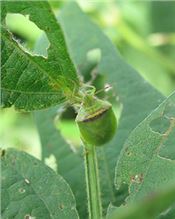|
Cold Weather Reduced Some Pests, Others Unaffected
BATON ROUGE, LA.
Many crop pests did not survive the record cold temperatures seen in Louisiana in mid-January, which is good news for farmers who are preparing for the upcoming growing season.
The bad news? Many pests – including mosquitoes, ticks and others that bother people – were unaffected by the frigid conditions.
Redbanded stink bugs are the No. 1 pest for soybean producers in Louisiana, according to LSU AgCenter entomologist Jeff Davis. He believes it will be difficult to find any redbanded stink bugs north of Interstate 10 in the state.
“From our observations, anytime you have temperatures below 23 degrees for 10 hours, you will see reductions of approximately 90 percent of redbanded stink bugs,” Davis said. “We were colder than that and for much longer than that.”
Davis said the main reason redbanded stink bugs are affected by the cold is the insect does not go into diapause, which is a hibernation-like state. The stink bug is an invasive species from Brazil where it does not experience the cold temperatures seen in Louisiana this month.
The freezing temperatures also affected the vegetation many pests rely on to overwinter.
“Without a green bridge to feed on, if an insect survived the cold, there is a good chance it may starve to death,” Davis said. “Red-banded stinkbugs depend on clover to survive, and if you look out there, virtually everything is brown.”
Most insect treatments soybean farmers use are to combat redbanded populations. Because their numbers will be down, farmers could save approximately $40 to $60 per acre, depending on how many treatments they normally make to fight the pest.
Unfortunately, the cold will not eradicate redbanded stink bugs. Davis expects the insects to be found in north Louisiana by the end of the season. But their numbers are not expected the reach the threshold for insect treatments.
Davis said that corn earworms numbers will also be reduced.
Soybean loopers and fall armyworms migrate to Louisiana later in the year, and the cold will have no effect on them, Davis said. Thrips, a common pest in cotton, migrate from California and Mexico, but their numbers are expected to be low early in the season when cotton is most vulnerable to insect damage.
While the cold was reducing problem pest populations, it was also reducing the number of beneficial insects.
AgCenter entomologist Rodrigo Diaz said the salvinia weevil had a hard time surviving the cold weather.
“I expect to see the populations of the weevil crash,” Diaz said.
The weevils play a crucial role in managing giant salvinia, one of the world’s most aggressive weeds in freshwater habitats. Under favorable growing conditions, giant salvinia can double its coverage in as few as 36 hours. In 2016, it could be found in more than 50 parishes in Louisiana.
“Salvinia can be protected from the cold in tree crevices or under plant debris. If all the weevils in an area died, it will be very easy for the plants to regenerate and take over an area,” Diaz said.
Research is ongoing to determine ways to increase the weevil survival. Some methods being examined include floating weevil nurseries using plastic rings to raise temperatures and increase their survival, and plant crowding, which creates a refuge-like effect and helps the plants – the weevil’s food source – and weevils survive.
AgCenter medical entomologist Kristin Healy said the cold will do little in the way of mosquito control.
“Some of the mosquitoes we have here are also found in New Jersey, so they can tolerate cold weather,” Healy said.
Healy said mosquitoes enter the diapause stage to help survive during the winter. Eggs of the Asian tiger mosquito, a mosquito found in Louisiana, have a high tolerance for cold and generally survive.
“West Nile virus is going to be a concern here every summer because we are always going to have mosquitoes,” Healy said.
Ticks are another pest that interact with humans and spread diseases such as Lyme’s disease and Rocky Mountain spotted fever. According to Healy, the cold will do little to affect their populations.
“Many of the ticks found here are also found as far north as Canada, so they are well adapted to the cold,” she said.
On a brighter note, Healy said that bees that were in good health and should not be adversely affected by the cold weather. But cold weather is another stressor that can affect colonies. ∆
 An adult salvinia weevil is pictured on a giant salvinia leaf. The weevils play a significant role in the management An adult salvinia weevil is pictured on a giant salvinia leaf. The weevils play a significant role in the management
of giant salvinia, an aggressive freshwater weed that is found in more than 50 Louisiana parishes. The weevils are
not very cold-tolerant, and an entomologist with the LSU AgCenter believes very few survived the frigid conditions
experienced recently in Louisiana.
Photo by Charles Wahl/LSU AgCenter

A close-up of a redbanded stink bug, which is the No. 1 pest in soybeans in Louisiana.
Redbanded stink bug populations are expected to be drastically reduced because the
insects are unable to survive extended periods of sub-freezing temperatures.
Photo by Jeff Davis/LSU AgCenter
|
|